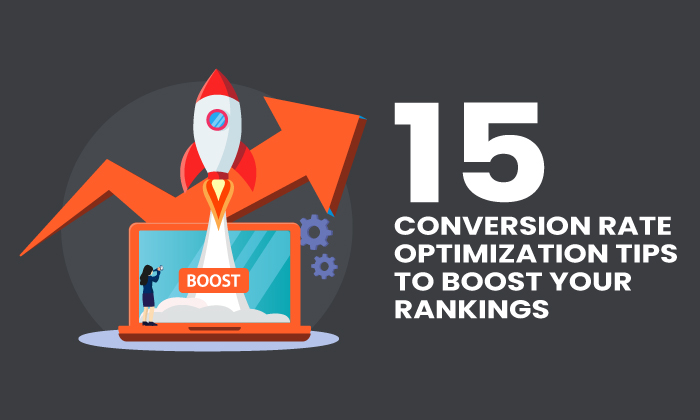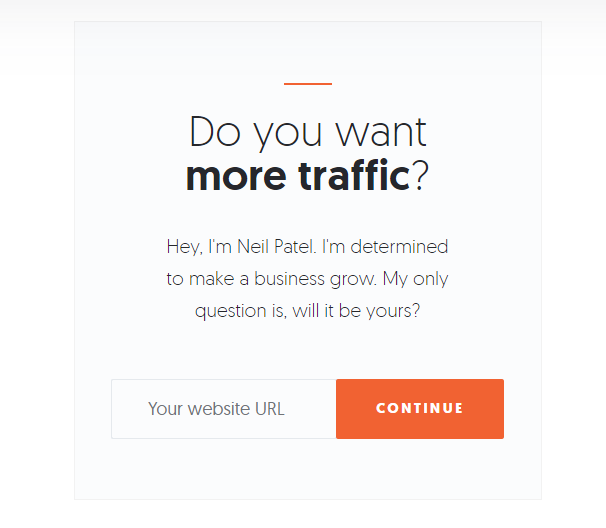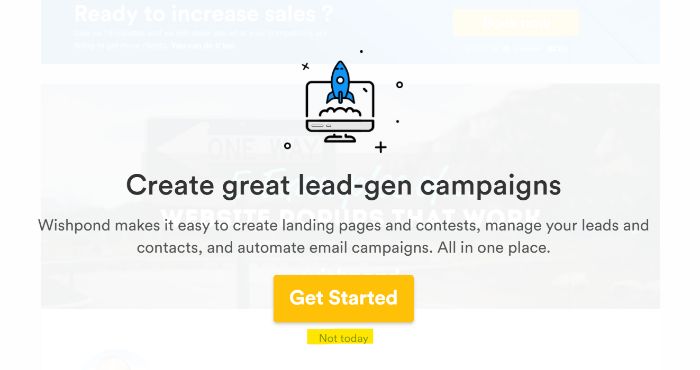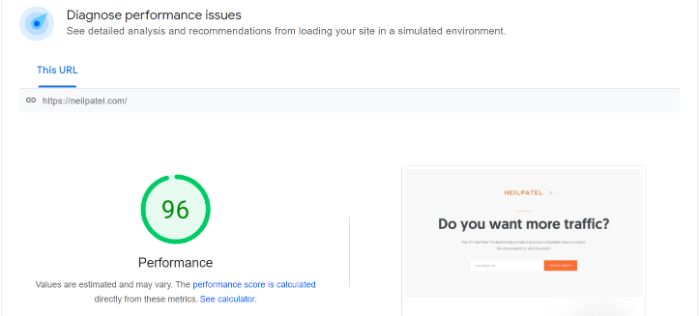
Conversion rate optimization, or CRO, is the process of optimizing your website to increase the completion of a specific action. In most cases, the desired action is an actual sale, but not always.
Desired actions could include demo sign-ups, downloading an asset from your website, trying out a new tool, or signing up for your newsletter. If it helps you grow your business, it’s a conversion—and it can be optimized.
The beauty of these conversion rate optimization tips is they work regardless of your intended conversion method.
CRO Tip 1: Add Site Search to Your Website
Up to 30 percent of visitors will use a search box if it’s offered. Unfortunately, nearly 84 percent of companies don’t optimize their on-site search to meet user expectations.
This means if your website doesn’t already include a site search, it’s time to consider adding it.
The main benefit of site search is user experience. However, data from search results can provide valuable insights into user behavior by showing you exactly what they’re searching for.
This information can help you tailor content to meet those needs or add new pages to your site to fill any gaps.
You may even be able to identify users in different parts of the funnel based on the search terms they use. This information can help you to narrow your customer’s most common questions and pain points, helping you tailor the website experience to their needs.
If you use WordPress, you can add a site search using a widget. If you use Webflow, they’ll actually let you customize it. Wix and Squarespace make it easy to add site search as well.
CRO Tip 2: Ensure Forms Are Easy to Fill Out
The average form abandonment rate is 68 percent—which means most people won’t finish filling out your form.
Website forms serve many purposes, including newsletter signup, lead magnet acquisition, and product/service inquiry.
Keep in mind: the easier a form is to fill out, the higher your expected conversion rates.
According to Hubspot research, a typical form has about 5 fields on average—and forms that are A/B tested get about 10 percent higher conversion rates.
In my experience, simple is better.

This is an example of a simple form I use on my blog. All the user needs to do is enter their website’s URL and the action is complete. It doesn’t get much simpler than that.
A few ways to ensure your forms are easy to fill out:
- make form names clear
- use proper HTML formatting
- use relevant sample placeholder text (I used “Your website URL” in the example above)
- have a distinct and easy-to-local submission button
CRO Tip 3: Improve your CTAs
If you want to improve conversions, CTAs are low-hanging fruit. The average CTA click-through rate is just 4.23 percent, but many factors can impact what helps your CTA convert.
For example, if you include more personalization in your CTAs, conversion rates can improve more than three times as much.
That’s why you should continually test CTAs to see what works and what needs improvement. You’d be surprised at how quickly user preference can change!
Start by testing these CTA elements:
- copy
- colors
- placement
- button shape
- button size
- page placement
Consider testing different types of CTAs as well. Here’s how CTA types convert, according to a study by Vye Agency:
- button CTAs have an average CTR of 5.31 percent
- text CTAs have an average CTR of 2.06 percent
- designed CTAs have an average CTR of 3.53 percent
When it comes to branding, consistency is key. However, using colors outside of your branding palette for CTAs is worth trying. Colors within your palette might blend in too well with the rest of your site, making them easy for website visitors to overlook.
CRO Tip 4: Run User Testing
Poor usability can kill your business. 70 percent of online businesses fail because of poor usability.
If you’re in e-commerce, your conversion rates could increase by 35 percent by just improving the design and flow of the user checkout process.
User testing is the way to get valuable data that can help you get more conversions across your website. So it’s important to get this process started as quickly as possible.
One of the most common ways to run UX testing is with heat maps, which show how users navigate your site and what interactive elements they’re clicking on.
You’ll see if they’re looking at your links, navigation bar tabs, CTAs, and so on. Some heat maps even incorporate eye-tracking software to show where your users look first.
There are several heat mapping tools on the market, but my favorites are Crazy Egg and Hotjar. If you decide to use Hotjar, the process for setting them up is very simple and straightforward.
CRO Tip 5: Add More (Better) Social Proof
More consumers than ever read social proof. In fact, 77 percent of users say they always or regularly read online reviews before buying.
You want to leverage customer loyalty as often as you can. Why? It’s free marketing and brand exposure. Even better, reviews can drive revenue.
According to Womply, businesses with more than average reviews across earn 54 percent more in annual revenue
It is also easy to create.
Social proof is a simple and great way to leverage user-generated content for your brand. This can include positive reviews and ratings, creative social media posts about your brand shared by customers and influencers, user-submitted content like photography, and more.
The benefit of adding more social proof to your website is it shows other users that other people trust you. Trust and credibility play a big factor in getting more conversions.
To add more social proof, try:
- Send a follow-up email asking for reviews.
- Host a contest with a branded hashtag on social media.
- Include a card with a branded hashtag when shipping physical products.
If you want to do it on a larger scale, consider automated tools like HotFomo and OptinMonster.
CRO Tip 6: Add Chatbots or Live Chat
If you have a question, wouldn’t you rather get the answer fast? That’s the idea behind chatbots. No matter how great your customer service is, sometimes call queues get long.
The good news? Users like chatbots. The average satisfaction rate of chatbots is 87.58 percent. They can also reduce customer service costs. One study predicts chatbots will save businesses $8 billion in customer service costs by 2022.
These tools help your brand build an instant connection with customers, making them more likely to purchase your product or service. Here are a few ways to leverage chatbots;
- answer FAQ
- qualify leads
- suggest related products
- troubleshoot common issues
- share information about new products
- increase your email list
With so many chatbot options available, it can be challenging to find the right one. I recommend focusing on native channel integrations to narrow your search.
If you want an app with widespread integration options, consider Landbot, which offers chat features through web, WhatsApp, Facebook Messenger, and API.
Perhaps you just need to integrate with Facebook Messenger? In that case, Chatfuel is an affordable solution.
Make sure that whatever chatbot you choose aligns with your business goals.
CRO Tip 7: Review Customer Persona and Adjust Your Messaging
A customer persona is a fictional snapshot of your ideal customer. Personas are commonly used by marketing agencies and businesses to give their target audience a human face. They can help drive leads, increase conversions, and shorten the sales cycle.
According to MarTech, creating a persona can increase email CTR by 14 percent—and conversion rates by 10 percent.
The gap between who you think your ideal customer is and your actual customers may be more significant than you think.
For example, if your personas are businesswomen in their early 30s but your customer base is primarily homemakers in their 50s, there’s going to be a massive disconnect in how you approach your target audience.
Here are six steps you can take to make sure you are targeting the right customer personas:
- Make a list of your highest value customers.
- Use a customer persona template to create a new persona.
- Start adding details from your highest value customers. Start with demographics like location, age, budget, education, etc.
- What channels do your highest value customers use to find you? Add that to your persona as “methods of communication.”
- Look at the content they consume—what does that tell you about their motivations? Add those to your template.
- Repeat the process for every product or service you offer.
It’s important to realign your customer personas with your messaging, sometimes as frequently as every two or three months. In some cases, this could mean tailoring your brand approach altogether to connect with the new target audiences working.
CRO Tip 8: Use Targeted Lead Magnets
Lead magnets are a free resource (like an ebook or guide) given away in exchange for user data. The most common lead magnets are PDFs or videos, but there are plenty of media types to use.
The best part? They work.
Fifty percent of marketers say lead magnets increase their conversion rates.
The more targeted your lead magnets, the more effective they are likely to be. The key is to get creative with your targeting.
You could even consider creating some more interactive lead magnets like quizzes or online calculators. According to LeadQuizzes, the average quiz has a lead capture rate or 31.6 percent.
The way you target your magnet will depend on your product or service. For example, if you serve a geographical area, it may make sense to target leads based on location. Other websites might target leads based on industry or how they got to the site.
Here are a few other targeting options:
- time on page
- type of content
- whether they’ve purchased before
- industry
- customer persona
- location
- time period (for example, a pop-up for an upcoming event)
Not sure how to add targeting to your lead magnet strategy? These lead magnet tools can help.
Whatever type of lead magnet you decide to create, be sure it aligns closely with your intended customer. Since the goal of lead magnets is to collect user data, you want to make sure the offer is valuable to your intended audience as well as your business.
CRO Tip 9: Use Pop-Ups Carefully
Pop-ups have an average conversion rate of 3.09 percent, which makes them ripe for CRO.
I have a love/hate relationship with pop-ups because they walk such a fine line between being beneficial (for you and your customer) and incredibly annoying. However, when done right, pop-ups can be an invaluable conversion tool.
In fact, Marketing 112 increased their conversion rates by 62 percent by adding a pop-up to its website.
First and foremost, your pop-ups should respect universal UX rules. These include fast load times, visible exit options (like the example from Wishpond below), and platform-appropriate size.
There should also be limits as to how often users see the pop-up. For example, a user who bypasses the pop-up once shouldn’t be bombarded with it on each page of your site they navigate.

When it comes to conversions, keep the messaging short with minimal effort to take the desired action.
You can also implement A/B testing to see how users interact with different versions of the pop-up. This is important for optimizing conversion rates across the board.
CRO Tip 10: Check Your Site Speed
If your site loads slowly, all of the conversion rate optimization tips in the world won’t make a difference. In fact, website conversion rates drop by 4.2 percent for each additional second your site takes to load.
Even more surprising? More than 80 percent of sites don’t meet acceptable speeds.
Fortunately, there are plenty of free sites and tools that let you test your site speed and troubleshoot common issues.
PageSpeed Insights and Pingdom are two of the industry leaders in this domain. These tools have been around for years and offer the most in-depth testing and troubleshooting. They first look at contentful paint, time to interactive, and total blocking time to calculate your overall score.

What are some of the most common issues that slow down site speed?
- render-blocking JavaScript
- poorly optimized CSS
- large media files
- bulky code
While some of these may require a database engineer or developer to resolve, you can usually start to tackle some issues (like large media files) on your own.
CRO Tip 11: Recover Lost Sales by Following up on Abandoned Carts
According to the Baymard Institute, the average cart abandonment rate is 69.82 percent. That rate is even higher on mobile where the average shopping cart abandonment rate is 85.65%.
Recovering just a fraction of those missed sales could do wonders for your conversion rate.
If the main benefit of CRO is converting users already on your site, then abandoned cart users are the cream of the crop. They actively started the transaction but didn’t complete the purchase.
There may be some obvious reasons for this, such as a discount code no longer being valid or high shipping rates. Whatever the reason, you should always aim to recover the lost sales using (almost) any means necessary.
In fact, if e-commerce sites just fixed checkout usability issues in their process, they could increase conversion rates by 35.26 percent. This translates into more than $200 billion in recovered sales from the e-commerce industry alone.
Here are some other ways you can recover abandoned carts:
- automated email flows
- on-site push notifications
- retargeting ads
- personal outreach
- automated social outreach
You don’t want to harass potential customers who have abandoned carts, but you do want them to feel wanted. Sending just one email could help you recover up to 29.9 percent of these sales.
You may want to play with your outreach timelines to find the right approach for your customer base.
CRO Tip 12: Make Sure Landing Pages Match Your Messaging
The average landing page converts just 2.35 percent of the time across all industries. If you want to be a top performer in your sector, you should be aiming for conversion rates above 10 percent.
So, how do you increase your landing page conversion rate?
One way is to ensure the messaging on your landing page matches the ad or copy that brought them there in the first place. This creates a more cohesive experience, showing users that your page is the right fit for what they want. It will also help improve your PPC quality score.
Here’s how to match your messaging:
- use similar language in your landing page and ad (especially the main keywords)
- keep branding consistent (include your logo and use brand colors)
- use a clear CTA on both your ad and landing page
Just imagine how off-putting two distinct messaging styles can be to the user. Imagine if you agreed to a job interview for a tech company and found out it was a restaurant when you arrived. It would feel like a bait and switch, right?
While a difference in messaging between an ad and landing page isn’t quite as off-putting, it’s close. The differences can be jarring and steer users away.
When creating your landing pages and ad copy, make sure you have a clear focus in mind for. This would start with your keyword research when you select the target phrase for the page. You can include some secondary keywords on the landing page as well if you plan to use them in your ad copy.
CRO Tip 13: Target High Intent Users
High intent users are very close to making a buying decision. According to a report by the CMO Council, 87 percent of B2B buyers say that online content has a major or moderate impact on the vendor they choose.
That means there’s an extremely high opportunity to improve your content to convert these users.
How can you target high-intent users?
As previously mentioned, looking at the internal search terms users interact with on your site is one way to get an idea of content that works. Someone at the bottom of the funnel might be trying to distinguish between different options, so they’ll be looking more closely at shipping timeframes and return policies.
Here are a few other strategies:
- Add high-intent keywords to your ads and landing pages. Use the information from your internal search to gauge what keywords are and how your customer base interacts with them.
- Build content that targets customer pain points. You can often identify these pain points with SERP analysis of high-intent keywords.
- Pay attention to intent data. Contact users who visit your pricing page, return to your site several times, or book a demo but don’t follow up.
High intent users are ready to convert, so don’t leave them hanging.
CRO Tip 14: Optimize Your Content
If your content isn’t performing well, it’s time to re-evaluate and optimize it. The first thing to check is title tags.
According to Backlinko’s research of more than 11 million Google search results, sites that include the main keyword in their title tag are far more likely to rank higher.
Content optimization looks at a number of factors including:
- making sure the keyword is used several times
- content length variance (add or remove content)
- check image optimization, such as size and alt tags
- add stats and new research
- check meta and SEO titles
- add keywords to more headings
- add a frequently asked questions section
- make sure you aren’t cannibalizing traffic from other content on your site
For time and efficiency, you don’t have to do all of the above. Instead, research the top 10 results on Google for your target keyword and see how they are structuring their content.
Their approach is clearly having an impact on their ranking and can provide a path for you to improve your search engine rankings.
CRO Tip 15: Before You Make Changes, See What Works Now
It’s easy to see all of the things that need to be improved, but what about the things that are working?
There are likely some areas of your website that are already working. For those, look for patterns in what the data is telling you, determine what the essential parts that led to the results might be, and come up with an approach to replicate this across your site.
If you aren’t sure how to approach this yourself, you can hire a professional to audit conversions across your website and highlight what is working well. This process alone could uncover a lot of great things you’ve been doing but probably don’t realize.
The last thing you want to do is a major content overhaul that loses conversions from pages or strategies that are already working.
Frequently Asked Questions About Conversion Rate Optimization Tips
What is conversion rate optimization?
Conversion rate optimization (CRO) is the process of increasing the conversion percentage for a website or mobile application. The aim is to increase the number of people taking the desired action in relation to the number of visits by improving customer experience and testing interactive elements.
What is the most effective CRO strategy?
There’s no one way to approach conversion rate optimization. However, a good CRO strategy will focus on user experience optimization, customer journey analysis, and website performance.
Is CRO different for ecommerce?
The benefits of CRO are the same whether they’re being implemented for an ecommerce site or not. However, the processes may differ slightly. When it comes to ecommerce, the conversion funnel has a larger part to play than it might on a non-ecommerce site.
How can conversion optimization affect your return on investment?
In simplest terms, CRO aims to make the most of the site traffic you already have. By increasing the conversion of your existing traffic, you have the potential to lower your customer acquisition costs.
{
“@context”: “https://schema.org”,
“@type”: “FAQPage”,
“mainEntity”: [
{
“@type”: “Question”,
“name”: “What is conversion rate optimization?”,
“acceptedAnswer”: {
“@type”: “Answer”,
“text”: ”
Conversion rate optimization (CRO) is the process of increasing the conversion percentage for a website or mobile application. The aim is to increase the number of people taking the desired action in relation to the number of visits by improving customer experience and testing interactive elements.
”
}
}
, {
“@type”: “Question”,
“name”: “What is the most effective CRO strategy?”,
“acceptedAnswer”: {
“@type”: “Answer”,
“text”: ”
There’s no one way to approach conversion rate optimization. However, a good CRO strategy will focus on user experience optimization, customer journey analysis, and website performance.
”
}
}
, {
“@type”: “Question”,
“name”: “Is CRO different for ecommerce?”,
“acceptedAnswer”: {
“@type”: “Answer”,
“text”: ”
The benefits of CRO are the same whether they’re being implemented for an ecommerce site or not. However, the processes may differ slightly. When it comes to ecommerce, the conversion funnel has a larger part to play than it might on a non-ecommerce site.
”
}
}
, {
“@type”: “Question”,
“name”: “How can conversion optimization affect your return on investment?”,
“acceptedAnswer”: {
“@type”: “Answer”,
“text”: ”
In simplest terms, CRO aims to make the most of the site traffic you already have. By increasing the conversion of your existing traffic, you have the potential to lower your customer acquisition costs.
”
}
}
]
}
Conclusion: Conversion Rate Optimization Tips
When you consider the fact that customer acquisition is more than half of the battle, it makes sense to focus heavily on conversion rate optimization.
After all, converting more of your existing website traffic could drastically reduce customer acquisition costs.
You’ll notice most CRO tips focus on improving the user experience and enhancing the customer journey. That’s because they tend to have the most significant impact. However, you don’t have to implement all of these CRO strategies immediately. Think about which will have the most significant impact and test those first.
Which of the CRO tips above do you think will have the most impact on your conversion rate?

